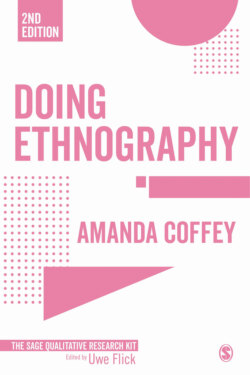Читать книгу Doing Ethnography - Amanda Coffey - Страница 22
На сайте Литреса книга снята с продажи.
Identifying suitable topics and problems
ОглавлениеEthnography is best suited to topics of exploration and discovery, rather than to questions of causality or narrow policy evaluation. Ethnographic research provides mechanisms for gaining understanding or exploring meaning as opposed to testing variables or identifying causes. Thus topics and questions that are suitable for ethnographic treatment are those which address process and practice – for example, how do things happen in the ways that they do? How are everyday activities organized? How do people in settings perceive and understand their daily work and lives? Questions such as these might be useful starting points for helping to identify a topic for exploration. Such questions are concerned with an intellectual curiosity for wanting to gain layered understandings of settings, communities, groups and cultures. They might also be accompanied by questions about or concerns with what matters within such settings – for example, what do people regard as important to them in their daily lives or work? What strategies are employed by people in order to get through or make sense of their experiences? What categories and devices are used by people to order, make sense of and account for actions and events? There is a long and distinguished tradition of institutional ethnography – of ethnographies of organizations for which such questions are particularly well suited. But ethnographic research does not need to be restricted to institutional settings, important and interesting though they are or might be. So alongside topics and questions which might enable detailed explorations of institutions such as schools, hospitals, business settings and prisons, the same curiosity in relation to ‘what’ and ‘how’ can be equally applicable to taxi drivers, family life, competitive swimmers, youth gangs or welfare activists. A key point here is that ethnographic research is an appropriate choice where questions focus on exploration and discovery, as well as on understanding settings from the perspectives of those who inhabit such spaces. Or to turn that around, ethnographic research can in and of itself be used to identify and define a research ‘problem’; that is, a focus of further exploration to aid understanding and sense making. Ethnographic research is also well suited to understanding and documenting process. This recognizes that social settings are dynamic and shifting spaces, with fluid boundaries and multiple perspectives that are brought to bear. There is a perception that ethnography is best suited to studying ‘naturally occurring’ settings, events and happenings – that are simply ‘there’ to be observed and understood. It is true that ethnography does not set out to ‘create’ artificial laboratory conditions through which to understand lives and cultures; however, there is a recognition that daily lives and settings are not in themselves particularly ‘naturally occurring’, but rather shaped and maintained through social and cultural boundaries and interactions.
Research questions help to formulate a structure through which we can seek to make sense of processes, practices, organizations, settings and lives in ethnographic research. In a spirit of discovery such questions should be open rather than closed, attendant to the possibilities rather than concerned with narrow and definitive answers. Ethnographic research does not and should not start with a lack of ideas or questions; we do not enter a setting with an empty mind, but rather an open mind. Openness in ethnographic research gives permission for refinement, for refreshing the topics to be examined and the problems to be explored. A ‘foreshadowed problem’, after Malinowski (1922) is a helpful concept here. A foreshadowed problem is not a problem in the sense of a problem to be resolved or solved. Rather it is a way of describing a ‘research problem’ – a topic to be explored or investigated or better understood. Foreshadowed problems can be identified through a range of sources – for example, from a personal interest in a setting or phenomenon, from theoretical work or comparative projects, from something that just appears interesting or unusual or unexplained, or from a chance encounter or opportune experience. Foreshadowed problems help us to both focus and to develop a set of open, reflective areas for initial exploration – important in designing an ethnographic project. Having a focus, with open and reflexive lines of inquiry to guide initial observation, listening and questioning will lead to a purposive and meaningful project. Foreshadowed problems can be used to develop guiding questions for the ethnographer to explore; they must also be identified in such a way that leaves open the possibility of surprise and of encountering the unexpected.
